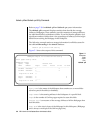
5-8 IBM Informix OnLine Database Server Administrator’s Guide
Apply Effective Criteria
Apply Effective Criteria
Looking at the efficiency information for blobspace bspc1 in Figure 5-1, an
administrator might decide that a better blob-storage strategy would be to
double the blobpage size from 2048 bytes to 4096 bytes. (Recall that blobpage
size is always a multiple of the OnLine page size.) If the administrator made
this change, the measure of page fullness would remain the same but the
number of locks needed during a blob update or modification would be
reduced by half.
The efficiency information for blobspace blobPIC reveals no obvious
suggestion for improvement. The two blobs in blobPIC differ greatly in size
and there is no optimal storage strategy. In general, blobs of similar size can
be stored more efficiently than blobs of different sizes.
Eliminate User-Created Resource Bottlenecks
OnLine manages limited resources such as locks, latches, buffers, and log
space. Users can adversely affect OnLine performance by inadvertently
creating resource bottlenecks in an otherwise efficiently tuned OnLine
system. (You can monitor the shared-memory resources being held by user
processes by executing tbstat -u. Refer to page 3-86 or page page 7-99.)
Knowledgeable users are able to avoid activities that can slow OnLine perfor-
mance for everyone. As administrator, you should encourage users to follow
these four guidelines:
■ Do not leave a transaction open without committing or rolling back within
a reasonable period of time.
If a user leaves a transaction open, the resources held by the database
server process are unavailable to other users. In addition, if the trans-
action is left open for an extended period, this user action can
become responsible for a long transaction error.
■ Do not stop a process using job control unless you are certain you can
terminate the job.
A stopped job does not release resources held by the database server
process. These resources might remain unavailable to other users. If
an application process is stopped while OnLine is engaged in data-
base activity on its behalf, serious concurrency delays can result.


















